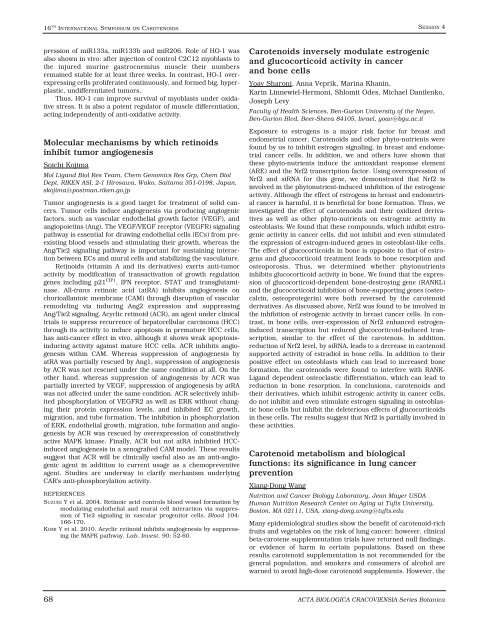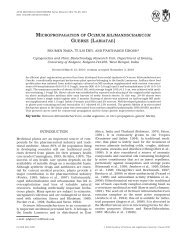ACTA BIOLOGICA CRACOVIENSIA
ACTA BIOLOGICA CRACOVIENSIA
ACTA BIOLOGICA CRACOVIENSIA
Create successful ePaper yourself
Turn your PDF publications into a flip-book with our unique Google optimized e-Paper software.
16 TH INTERNATIONAL SYMPOSIUM ON CAROTENOIDS<br />
pression of miR133a, miR133b and miR206. Role of HO-1 was<br />
also shown in vivo: after injection of control C2C12 myoblasts to<br />
the injured murine gastrocnemius muscle their numbers<br />
remained stable for at least three weeks. In contrast, HO-1 overexpressing<br />
cells proliferated continuously, and formed big, hyperplastic,<br />
undifferentiated tumors.<br />
Thus, HO-1 can improve survival of myoblasts under oxidative<br />
stress. It is also a potent regulator of muscle differentiation,<br />
acting independently of anti-oxidative activity.<br />
Molecular mechanisms by which retinoids<br />
inhibit tumor angiogenesis<br />
Soichi Kojima<br />
Mol Ligand Biol Res Team, Chem Genomics Res Grp, Chem Biol<br />
Dept, RIKEN ASI, 2-1 Hirosawa, Wako, Saitama 351-0198, Japan,<br />
skojima@postman.riken.go.jp<br />
Tumor angiogenesis is a good target for treatment of solid cancers.<br />
Tumor cells induce angiogenesis via producing angiogenic<br />
factors, such as vascular endothelial growth factor (VEGF), and<br />
angiopoietins (Ang). The VEGF/VEGF receptor (VEGFR) signaling<br />
pathway is essential for drawing endothelial cells (ECs) from preexisting<br />
blood vessels and stimulating their growth, whereas the<br />
Ang/Tie2 signaling pathway is important for sustaining interaction<br />
between ECs and mural cells and stabilizing the vasculature.<br />
Retinoids (vitamin A and its derivatives) exerts anti-tumor<br />
activity by modification of transactivation of growth regulation<br />
genes including p21 CIP1 , IFN receptor, STAT and transglutaminase.<br />
All-trans retinoic acid (atRA) inhibits angiogenesis on<br />
chorioallantoic membrane (CAM) through disruption of vascular<br />
remodeling via inducing Ang2 expression and suppressing<br />
Ang/Tie2 signaling. Acyclic retinoid (ACR), an agent under clinical<br />
trials to suppress recurrence of hepatocellular carcinoma (HCC)<br />
through its activity to induce apoptosis in premature HCC cells,<br />
has anti-cancer effect in vivo, although it shows weak apoptosisinducing<br />
activity against mature HCC cells. ACR inhibits angiogenesis<br />
within CAM. Whereas suppression of angiogenesis by<br />
atRA was partially rescued by Ang1, suppression of angiogenesis<br />
by ACR was not rescued under the same condition at all. On the<br />
other hand, whereas suppression of angiogenesis by ACR was<br />
partially inverted by VEGF, suppression of angiogenesis by atRA<br />
was not affected under the same condition. ACR selectively inhibited<br />
phosphorylation of VEGFR2 as well as ERK without changing<br />
their protein expression levels, and inhibited EC growth,<br />
migration, and tube formation. The inhibition in phosphorylation<br />
of ERK, endothelial growth, migration, tube formation and angiogenesis<br />
by ACR was rescued by overexpression of constitutively<br />
active MAPK kinase. Finally, ACR but not atRA inhibited HCCinduced<br />
angiogenesis in a xenografted CAM model. These results<br />
suggest that ACR will be clinically useful also as an anti-angiogenic<br />
agent in addition to current usage as a chemopreventive<br />
agent. Studies are underway to clarify mechanism underlying<br />
CAR's anti-phosphorylation activity.<br />
REFERENCES<br />
SUZUKI Y et al. 2004. Retinoic acid controls blood vessel formation by<br />
modulating endothelial and mural cell interaction via suppression<br />
of Tie2 signaling in vascular progenitor cells. Blood 104:<br />
166-170.<br />
KOMI Y et al. 2010. Acyclic retinoid inhibits angiogenesis by suppressing<br />
the MAPK pathway. Lab. Invest. 90: 52-60.<br />
Carotenoids inversely modulate estrogenic<br />
and glucocorticoid activity in cancer<br />
and bone cells<br />
Yoav Sharoni, Anna Veprik, Marina Khanin,<br />
Karin Linnewiel-Hermoni, Shlomit Odes, Michael Danilenko,<br />
Joseph Levy<br />
Faculty of Health Sciences, Ben-Gurion University of the Negev,<br />
Ben-Gurion Blvd, Beer-Sheva 84105, Israel, yoav@bgu.ac.il<br />
Exposure to estrogens is a major risk factor for breast and<br />
endometrial cancer. Carotenoids and other phyto-nutrients were<br />
found by us to inhibit estrogen signaling, in breast and endometrial<br />
cancer cells. In addition, we and others have shown that<br />
these phyto-nutrients induce the antioxidant response element<br />
(ARE) and the Nrf2 transcription factor. Using overexpression of<br />
Nrf2 and siRNA for this gene, we demonstrated that Nrf2 is<br />
involved in the phytonutrient-induced inhibition of the estrogenic<br />
activity. Although the effect of estrogens in breast and endometrial<br />
cancer is harmful, it is beneficial for bone formation. Thus, we<br />
investigated the effect of carotenoids and their oxidized derivatives<br />
as well as other phyto-nutrients on estrogenic activity in<br />
osteoblasts. We found that these compounds, which inhibit estrogenic<br />
activity in cancer cells, did not inhibit and even stimulated<br />
the expression of estrogen-induced genes in osteoblast-like cells.<br />
The effect of glucocorticoids in bone is opposite to that of estrogens<br />
and glucocorticoid treatment leads to bone resorption and<br />
osteoporosis. Thus, we determined whether phytonutrients<br />
inhibits glucocorticoid activity in bone. We found that the expression<br />
of glucocorticoid-dependent bone-destroying gene (RANKL)<br />
and the glucocorticoid inhibition of bone-supporting genes (osteocalcin,<br />
osteoprotegerin) were both reversed by the carotenoid<br />
derivatives. As discussed above, Nrf2 was found to be involved in<br />
the inhibition of estrogenic activity in breast cancer cells. In contrast,<br />
in bone cells, over-expression of Nrf2 enhanced estrogeninduced<br />
transcription but reduced glucocorticoid-induced transcription,<br />
similar to the effect of the carotenois. In addition,<br />
reduction of Nrf2 level, by siRNA, leads to a decrease in caotenoid<br />
supported activity of estradiol in bone cells. In addition to their<br />
positive effect on osteoblasts which can lead to increased bone<br />
formation, the carotenoids were found to interfere with RANK-<br />
Ligand dependent osteoclastic differentiation, which can lead to<br />
reduction in bone resorption. In conclusions, carotenoids and<br />
their derivatives, which inhibit estrogenic activity in cancer cells,<br />
do not inhibit and even stimulate estrogen signaling in osteoblastic<br />
bone cells but inhibit the deleterious effects of glucocorticoids<br />
in these cells. The results suggest that Nrf2 is partially involved in<br />
these activities.<br />
Carotenoid metabolism and biological<br />
functions: its significance in lung cancer<br />
prevention<br />
Xiang-Dong Wang<br />
SESSION 4<br />
Nutrition and Cancer Biology Laboratory, Jean Mayer USDA<br />
Human Nutrition Research Center on Aging at Tufts University,<br />
Boston, MA 02111, USA, xiang-dong.wang@tufts.edu<br />
Many epidemiological studies show the benefit of carotenoid-rich<br />
fruits and vegetables on the risk of lung cancer; however, clinical<br />
beta-carotene supplementation trials have returned null findings,<br />
or evidence of harm in certain populations. Based on these<br />
results carotenoid supplementation is not recommended for the<br />
general population, and smokers and consumers of alcohol are<br />
warned to avoid high-dose carotenoid supplements. However, the<br />
68 <strong>ACTA</strong> <strong>BIOLOGICA</strong> <strong>CRACOVIENSIA</strong> Series Botanica












